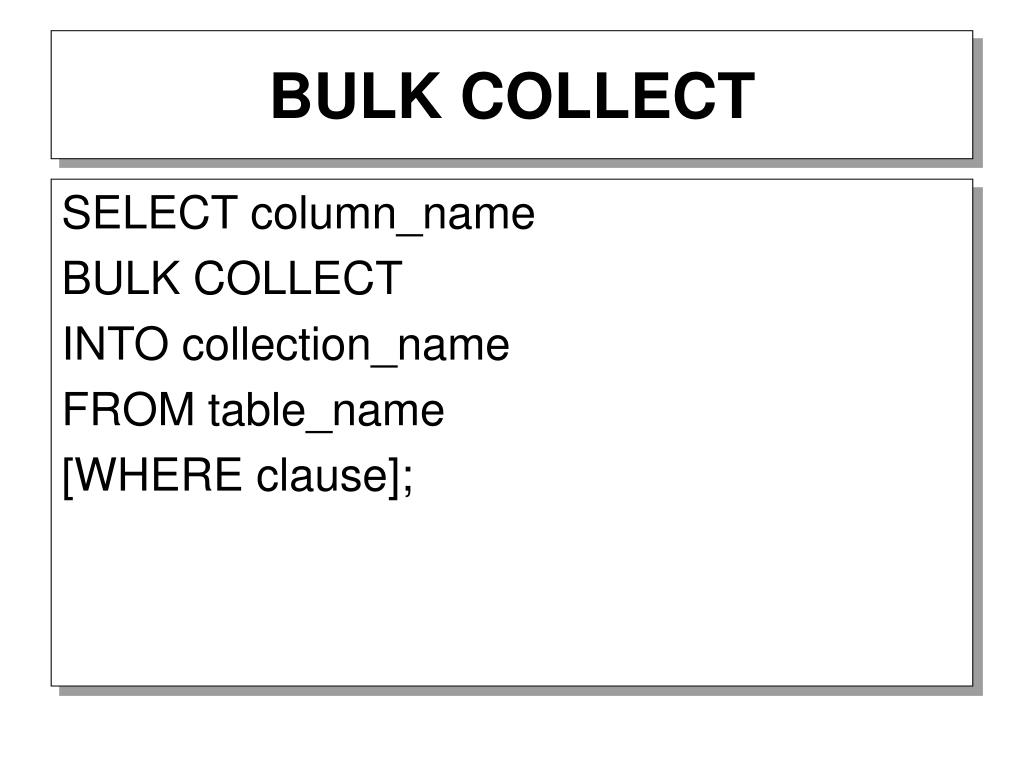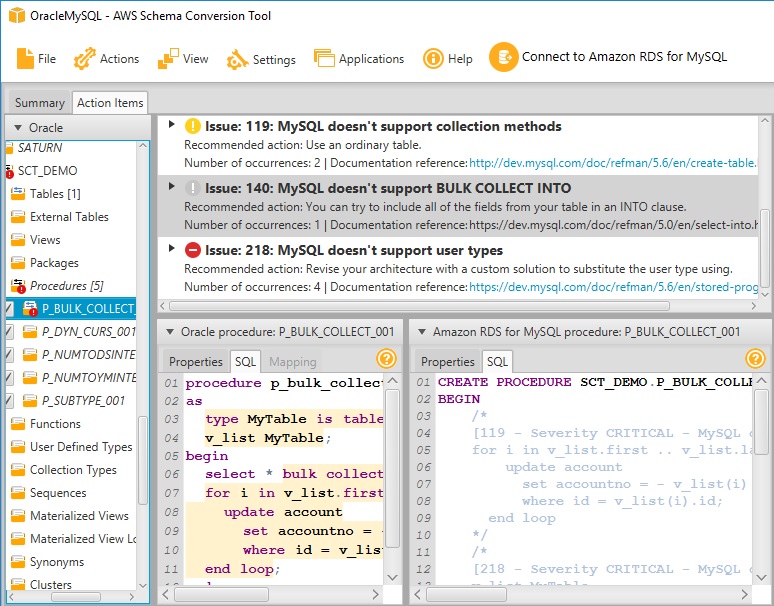
Oracle PL/SQL BULK COLLECT
PROCEDURE process_all_rows IS TYPE employees_aat IS TABLE OF employees%ROWTYPE INDEX BY PLS_INTEGER; l_employees employees_aat; BEGIN SELECT * BULK COLLECT INTO l_employees FROM employees; FOR indx IN 1 .. l_employees.COUNT LOOP analyze_compensation (l_employees (indx)); END LOOP; END process_all_rows;

Bulk Collect With Execute Immediate Of Dynamic SQL In Oracle Database RebellionRider
Use BULK COLLECT with the SELECT statement in PL/SQL to retrieve rows without using a cursor. This example selects all rows from the departments table for a specified location into a nested table, then uses a FOR LOOP to output data.

Introduction To Plsql Bulk Collect In Oracle Database Rebellionrider How Use Clause With Select
In the Oracle database, there is an area that runs the SQL code (SELECT, UPDATE, etc) and an area that runs the PL/SQL code (LOOP, IF, etc). Whenever a procedure or function needs to switch between these two areas, it's called a context switch.. BULK COLLECT: a clause to let you fetch multiple rows into a collection; FORALL: a feature to.

Top 9 oracle bulk collect insert in 2022 Gấu Đây
To view Oracle collection data using tools that require a conventional format, you must unnest, or flatten, the collection attribute of a row into one or more relational rows.. The PL/SQL BULK COLLECT clause is an alternative to using DML statements, which can be time consuming to process. You can return an entire result set in one operation.
Introduction To Plsql Bulk Collect In Oracle Database Rebellionrider How Use Clause With Select
BULK COLLECT is one of the way of fetching bulk collection of data. With Oracle bulk collect, the PL/SQL engine tells the SQL engine to collect many rows at once and place them into a collection. During an Oracle bulk collect, the SQL engine retrieves all the rows and loads them into the collection and switches back to the PL/SQL engine.

Oracle PL/SQL BULK COLLECT
BULK COLLECT: These are SELECT statements that retrieve multiple rows with a single fetch, thereby improving the speed of data retrieval. FORALL: These are INSERT, UPDATE, and DELETE operations that use collections to change multiple rows of data very quickly.

PPT Oracle 8i PowerPoint Presentation, free download ID3195900
1 Given the following Oracle function: CREATE or REPLACE FUNCTION foo (id NUMBER, category VARCHAR) RETURN CHAR IS TYPE MY_ARRAY2 IS TABLE OF NUMBER; MY_ARRAY MY_ARRAY2; BEGIN SELECT my_id BULK COLLECT INTO my_array FROM my_table RETURN ( CASE WHEN category = 'FOO' AND (id member of MY_ARRAY) THEN 'Y' ELSE 'N' END ); END;

Oracle PL SQL Learn Bulk Collect and FOR ALL Bulk Collect and LIMIT With Example YouTube
In PL/SQL, the BULK COLLECT feature is used to enhance the performance of SQL queries by fetching multiple rows at once and storing them in collections ( arrays or nested tables) rather than processing one row at a time. This reduces the number of context switches between the SQL engine and the PL/SQL engine, resulting in improved efficiency.

Oracle PL/SQL BULK COLLECT
You can use the BULK COLLECT INTO clause with the EXECUTE IMMEDIATE statement to store values from each column of a query's result set in a separate collection. You can use the RETURNING BULK COLLECT INTO clause with the EXECUTE IMMEDIATE statement to store the results of an INSERT, UPDATE, or DELETE statement in a set of collections. FETCH
[Solved] how to use bulk collect instead of a loop in 9to5Answer
A bulk collect is a method of fetching data where the PL/SQL engine tells the SQL engine to collect many rows at once and place them in a collection. The SQL engine retrieves all the rows and loads them into the collection and switches back to the PL/SQL engine. All the rows are retrieved with only 2 context switches.
[Solved] Oracle Bulk Collect performance 9to5Answer
Using BULK COLLECT/FORALL I have a procedure that was previously using a 'slow-by_slow' type procedure. I've converted it to BULK COLLECT and FORALL (test_cur, see livesql).The procedure is obtaining data from 2 tables then inserts this data into 2 corresponding tables. I'd like to use the data and modify it slightly be

Introduction To Plsql Bulk Collect In Oracle Database Rebellionrider How Use Clause With Select
Tutorial Bulk Processing with PL/SQL Description Learn how to make the most of the bulk processing features of PL/SQL: BULK COLLECT and FORALL. Be sure to run the setup code before trying to execute code in the modules. And you can re-run that setup code at any time if you'd like to reset the employees table to its "original" state.

Bulk Collect/Sql/Oracle/Sql Interview science YouTube
BULK COLLECT Bulk binds can improve the performance when loading collections from a queries. The BULK COLLECT INTO construct binds the output of the query to the collection. To test this create the following table. CREATE TABLE bulk_collect_test AS SELECT owner, object_name, object_id FROM all_objects;

How to convert Oracle BULK COLLECT clause to MySQL
What is BULK COLLECT? BULK COLLECT reduces context switches between SQL and PL/SQL engine and allows SQL engine to fetch the records at once. Oracle PL/SQL provides the functionality of fetching the records in bulk rather than fetching one-by-one.

How To Use PL/SQL Bulk Collect Clause With FETCH INTO Statement RebellionRider
The bulk_collect.sql script defines a collection with the same rowtype as the test table. It then populates the collection by manually extending and setting the values of the rows. Finally it populates the collection using a bulk operation. The output from this script is shown below. SQL> @bulk_collect.sql.

Importance of BULK COLLECT in Oracle PL/SQL DOTC_MDB
The syntax for using PL/SQL Bulk Collect Clause with Select-Into statement in Oracle Database is as follow: SELECT column_list BULK COLLECT INTO collection_datatype_name FROM table_name WHERE